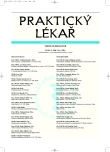-
Medical journals
- Career
Haemolytic anemia due to ribavirin – clinical observations and treatment
Authors: J. Stránský
Authors‘ workplace: Přednosta: prof. MUDr. Jiří Horák, CSc. ; I. interní klinika FNKV a 3. LF UK Praha
Published in: Prakt. Lék. 2007; 87(7): 435-437
Category: Therapy
Overview
This article reviews the haematological complications of the antiviral treatment of chronic hepatitis C virus infection with a combination of pegylated and nonpegylated alpha-2a and alpha-2b interferons plus ribavirin. The major side effect of combination therapy is haemolytic anemia which usually develops 4–8 weeks after initiation of treatment, and is ribavirin dose-dependent. The main risk factors of haemolytic anemia due to ribavirin in combination therapy are: higher baseline haemoglobin levels and a lower platelets count, dose of alpha-interferon administered, higher iron saturation, haptoglobin phenotype, renal function (lower baseline creatinine clearance), age (older patients are more at risk) and sex (males are more at risk). Overall risk of ribavirin-induced haemolytic anemia was 9 %. Epoetin alpha seems to be a very promising drug for the treatment of haemolytic anemia and ribavirin dose maintenance.
Key words:
haemolytic anemia, ribavirin, epoetin alpha, chronic hepatitis C.
Labels
General practitioner for children and adolescents General practitioner for adults
Article was published inGeneral Practitioner

2007 Issue 7-
All articles in this issue
- Psychological aspects of acute pain
- Informed consent in practice in Czech health clinics
- Estimation of the left ventricle ejection fraction based on the distance from the mitral valve anterior cusp to the interventricular septum.
- Cardiac surgery in elderly patients. Where is the risk threshold?
- Assessing oral health-related quality of life in Czech population
- Acute neuroborreliosis
- Cardiac complications of subarachnoidal haemorrhage.
- Diagnosyis – iron deficiency
- Haemolytic anemia due to ribavirin – clinical observations and treatment
- Metastatic occurrencies of the uvea
- Nutritional supplements in Cardiology. What should we recommend to our patients?
- An update on the Global strategy for diagnosis, management, and prevention of chronic obstructive pulmonary disease – as viewed from the current situation in the Czech Republic.
- Energy expenditure and options for assessing energy requirements.
- General Practitioner
- Journal archive
- Current issue
- Online only
- About the journal
Most read in this issue- Acute neuroborreliosis
- Diagnosyis – iron deficiency
- Assessing oral health-related quality of life in Czech population
- Psychological aspects of acute pain
Login#ADS_BOTTOM_SCRIPTS#Forgotten passwordEnter the email address that you registered with. We will send you instructions on how to set a new password.
- Career

